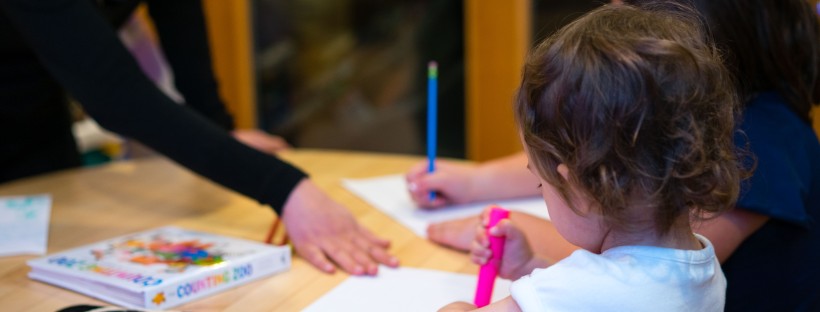Young children learn and process new concepts at an incredible pace. Just think about language acquisition. Children begin speaking, on average, around 12 months. By age two they have about 50 words and by three years old (Johns Hopkins Medicine), most can speak full sentences and express complex ideas and thoughts. Since everything is new to children, they process and interpret things differently than adults. In early childhood classrooms, it is important to capture the children’s learning and thinking. Documenting children’s learning helps in understanding how children think, this in turn can aid in the plannin process for educators as well as offer opportunities for reflection, both in student and educators.
One of the best ways to capture children’s learning and their thinking process right when it happens is to carry sticky notes, or a small notepad and writing utensil with you at all times in the classroom. Whenever I am in a classroom working with children, I always have sticky notes and pencil in my pocket. If I wait to record what is happening, there is a higher chance I will forget or misremember what happend or what was said. If I need to get up to search for a recording device too much time passes, or I interrupt the moment and risk distrupting a child’s thought process and lose the sincerity of the moment. Ideally, documenting children’s learning should not be intrusive and should not interrupt the child and their thinking and learning. The educator should be able to seamlessly document the children’s learning while still engaging with the children. Taking a picture of children to help document their learning is only the beginning. It is important to have multiple means and use varied media, such as recording conversations, to help document learning.
I recorded a conversation I had with a child who was between 3-4 years old. I used short hand notes while recording the conversation and was careful and deliberate when taking notes to keep my focus on the child and not lose the connection I had with her. This takes a lot of practice. It is important to be able to take notes that will be short and concise while still being able to decipher them at a later date. It is also important to be able to take notes while not always having to look at what you’re writing. You want to make sure the children know that they are your main focus.
Here is my conversation with Iris (I changed her name for this post) and the accompanying pictures:
Background:
This took place at the “painting Matzah table”. Iris was painting the Matzah with a roller brush, I noticed there was paper as well. I said “I wonder if I paint the paper will there be a different pattern than when I paint the Matzah?” I used the brush with many strands to “stamp” the paper producing dot like shapes and then I said “I wonder what the pattern looks like when I do long strokes and use the brush like this” creating two different patterns on separate papers. I was just speaking out loud, not necessarily speaking directly to Iris. She was painting her matzah while watching me. This is the conversation that followed:
Iris: pointing to the one that resembled dots) “this looks like prints” and, (pointing to the one with long strokes) “this looks like tracks”.
Natalie: Those area great words! I wonder what the difference between tracks and prints is? Hm….
Iris: hm… those are footprints and those are tracks (pointing to the respective papers) (she knows that they look different and she labeled them differently but she can’t explain it yet, my goal is to get her to explain her thinking and reasoning behind why she labeled them differently)
Natalie: Oh so those are FOOTprints…feet made that pattern
Iris: Yes, people made those. I make footprints in the snow when I walk
Natalie: And what made these tracks?
Iris: someone dragging something
Natalie: so there is a difference between footprints and tracks
Iris: Yes, someone walks to make these and someone drags something to make these (pointing to respective picture).
Natalie: hm, I see
Iris: yes, and someone can drag their feet to make the tracks.
Natalie: oh so a person can use their feet to make footprints and tracks?
Iris: Yes
Natalie: I wonder what else can make these tracks?
Iris: (pausing to think, continues to paint matzah, about a 20 second silence) A stick! If you drag a stick you can make this track!
Natalie: I think that would work too! I would love to test out your theories!
Iris: I have a dinosaur path (described a carpet at home with dinosaurs and walking paths and footprints)
We then tried the roller brush on the paper that she was using on the matzah and it made a different pattern. She said that if you drag your feet sideways it would make that track.
In capturing this conversation, I was able to discover a few things about this child and her thinking. I get insights into her previous experiences and knowledge of snow, dinosaurs, footprints, and tracks. I also get to know her better since she shares some facts about her home, specifically her dinosaur-path rug. I can use this knowledge to plan curriculum for the students such as experiments with footprints and tracks, comparing different materials to make the tracks in, snow, sand, ice, paint, grass etc., and track making materials (sticks, feet, shoes). This investigation could last weeks or months depending on the interest of the children.



You must be logged in to post a comment.